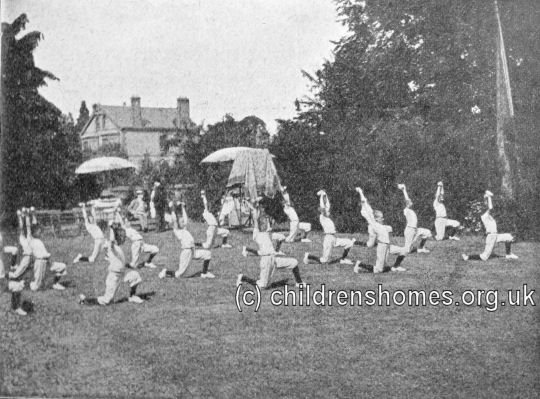Leicester Home for Boys / Working Boys' Home, Leicester, Leicestershire
The proposal for what became the Leicester Home for Boys was made in 1888 at a meeting convened by Mr T Goodwin Perkins, a lay preacher at St Matthew's Church, Leicester. From this meeting, the home was founded in two small cottages and by the following year, nine boys were being cared for and trained by Mr Perkins. Following his departure for Devon, the home was taken over in June 1889 by the Waifs and Strays Society as their diocesan institution and transferred to larger premises at Fern Bank, 173 Avenue Road, Leicester.

Former Leicester Home for Boys, Fern Bank, Leicester, 2013. © Peter Higginbotham
In 1892, an adjoining cottage was rented for use a Working Boys' Home, housing older boys who had entered employment. A further cottage was added in 1893, taking the total capacity to 19 boys in Fern Bank plus 11 in the cottages. All the boys attended the Sunday school at St John the Baptist's Church, with the younger ones also going to the Clarendon Park National School during the week.
In 1898, the Boys' Home and the Working Boys' Home both moved about twenty yards to Stoneygate House, a large property on a part of Avenue Road known as Stoneygate Grove. The new premises required extensive and expensive alterations but eventually provided accommodation for 35 boys aged from 8 to 12 at their date of admission. The building was officially opened on September 23rd, 1898, by Lady Mary Carr Glyn.

Home for Boys, Stoneygate Grove, Leicester, 1898. © Peter Higginbotham

Opening of Home for Boys, Stoneygate Grove, Leicester, 1898. © Peter Higginbotham
The Working Boys' section of the home was closed in around 1905, with the Boys' Home then taking over the whole building. The premises then accommodated 35 boys aged 8 to 13.
Physical exercise formed part of each day's routine and included dumb-bell drill and gymnastics.

Dumb-bell drill at Home for Boys, Stoneygate Grove, Leicester, c.1901. © Peter Higginbotham

Dumb-bell drill at Home for Boys, Stoneygate Grove, Leicester, c.1901. © Peter Higginbotham

Gymnastics at Home for Boys, Stoneygate Grove, Leicester, c.1901. © Peter Higginbotham
Boys from the home learned to swim at a local swimming bath.

Swimming lessons for Home for Boys, Stoneygate Grove, Leicester, c.1901. © Peter Higginbotham
Singing was another popular activity. In 1912, the Home's choir won a prize-singing competition.

Winning singers from Home for Boys, Stoneygate Grove, Leicester, 1912. © Peter Higginbotham

Leicester Home for Boys, Leicester, c.1927. © Peter Higginbotham
In 1948, the home was closed and the boys transferred to the new Buckhurst Home on London Road, Leicester.
Stoneygate House was later occupied by the Vernon House home for aged ladies and the property has now been rebuilt.
Records
Note: many repositories impose a closure period of up to 100 years for records identifying individuals. Before travelling a long distance, always check that the records you want to consult will be available.
- Index of the Society's first 30,000 children's case files ordered by surname.
- Index of the Society's first 30,000 children's case files ordered by date of birth.
- The Children's Society Records and Archive Centre is at Unit 25, Springfield House, 5 Tyssen Street, London E8 2LZ (email: archives@childrenssociety.org.uk). Files for children admitted to its homes after September 1926 were microfilmed in the 1980s and the originals destroyed. Some post-1926 files had already been damaged or destroyed during a flood. The Society's Post-Adoption and Care Service provides access to records, information, advice, birth record counselling, tracing and intermediary service for people who were in care or adopted through the Society.
- The Society has produced detailed catalogues of its records relating to disabled children, and of records relating to the Children's Union (a fundraising body mostly supported from the contributions of children).
Bibliography
- Bowder, Bill Children First: a photo-history of England's children in need (1980, Mowbray)
- Church of England Waifs and Strays' Society [Rudolfe, Edward de Montjoie] The First Forty Years: a chronicle of the Church of England Waifs and Strays' Society 1881-1920 (1922, Church of England Waifs and Strays' Society / S.P.C.K.)
- Higginbotham, Peter Children's Homes: A History of Institutional Care for Britain's Young (2017, Pen & Sword)
- Morris, Lester The Violets Are Mine: Tales of an Unwanted Orphan (2011, Xlibris Corporation) — memoir of a boy growing up in several of the Society's homes (Princes Risborough, Ashdon, Hunstanton, Leicester) in the 1940s and 50s.
- Rudolf, Mildred de Montjoie Everybody's Children: the story of the Church of England Children's Society 1921-1948 (1950, OUP)
- Stroud, John Thirteen Penny Stamps: the story of the Church of England Children's Society (Waifs and Strays) from 1881 to the 1970s (1971, Hodder and Stoughton)
Links
- Hidden Lives Revealed — the story of the children who were in the care of The Children's Society in late Victorian and early 20th Century Britain.
- The Children's Society
Except where indicated, this page () © Peter Higginbotham. Contents may not be reproduced without permission.


